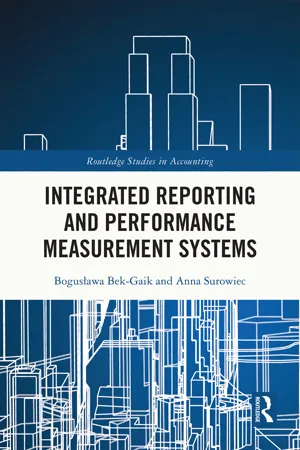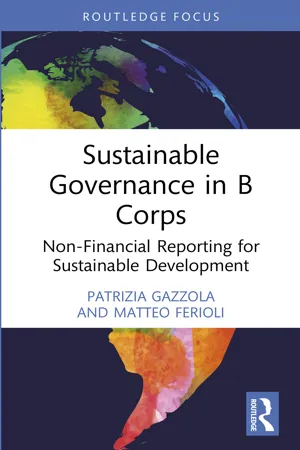Business
Non-Financial Data
Non-financial data refers to information that is not directly related to monetary transactions or financial performance. This type of data can include metrics such as customer satisfaction scores, employee engagement levels, environmental impact measurements, and social responsibility initiatives. Non-financial data provides insights into various aspects of a business's operations, impact, and relationships beyond its financial performance.
Written by Perlego with AI-assistance
Related key terms
Related key terms
1 of 4
Related key terms
1 of 3
3 Key excerpts on "Non-Financial Data"
- Bogusława Bek-Gaik, Anna Surowiec(Authors)
- 2023(Publication Date)
- Routledge(Publisher)
Sobańska, 2003 , p. 248).The growing significance of non-financial reporting stems from enterprises’ pursuit of social responsibility. Stakeholders require information on an organization's ecological, social responsibility, and ethical performance (Ernst and Young, 2011), which is not fully provided by financial statements. Hence, there is a need to include non-financial information in the content of the report or supplement existing financial statements with new, separate reports to ensure all stakeholders are satisfied. Further, according to the literature, voluntary non-financial disclosures reduce information asymmetry between organizations and investors (Albers and Günther, 2010 ).The disclosure of non-financial information together with financial statements helps stakeholders understand the organization's business model and the ability to create value and enable rational investment decisions.Considering these facts, reporting should be based on two main types of reporting: financial and non-financial. Disclosing non-financial information with financial statements can help stakeholders understand the general condition of the organization and enable more rational business decisions. Therefore, non-financial information should supplement financial information beyond traditional financial indicators.Based on a review of the literature, the development of company reporting makes it possible to distinguish the stages in the development of reporting (Table 1.1 ): financial reporting, sustainability reporting, and integrated reporting (Bobitan and Petru, 2017 ). According to Marcinkowska (2004)- eBook - ePub
Governance, Stewardship and Sustainability
Theory, Practice and Evidence
- George Dallas, Mike Lubrano(Authors)
- 2022(Publication Date)
- Routledge(Publisher)
Although challenges remain for companies, investors and other stakeholders to keep abreast of international, national, industry and other sustainability standards, the launch of the International Sustainability Standards Board (ISSB), together with a number of important regulatory developments, especially in the EU, made 2021–22 a watershed period for harmonisation of environmental and social reporting standards. This chapter provides a general overview of the main sources of ESG data, standards and ratings currently available to investors. It is also intended to help investors sift through the multiplicity of sources to identify those most likely to contribute meaningfully to the quality of the stewardship activities they carry out. This chapter also provides a summary of the state of play around ESG reporting standards in the aftermath of the important developments of 2021 and 2022.1. WHAT ARE ESG DATA?
If one adopts a broad definition of ESG, much of the information on companies that is not narrowly financial or operational in nature probably falls within the category of ESG data. A more practical formulation, and the one we will follow here, is that ESG data include any information that can potentially assist investors (along with other stakeholders) to evaluate the potential ESG-related risks, performance and impact of a particular company. This definition also encompasses information on other companies, along with industry-, sector-, country- and market-wide indicators against which to measure a particular company’s ESG performance and impact compared with relevant peer groups, standards and benchmarks.The amount of ESG data available to investors and other stakeholders has grown substantially over the last three decades. Market, regulatory and technological factors have accelerated the ability of companies, investors and other actors to collect information relevant to the ESG practices and performance of enterprises, and their impact on stakeholders. These factors have also combined to encourage and facilitate the dissemination of such information to financial and non-financial stakeholders alike.The diversity of sources of ESG data means that the quality and comparability of much of it is questionable. The sheer volume of information itself now poses challenges for investors and other stakeholders. Resource limitations require investors to be selective in the types and amount of data they access and analyse in their decision-making processes. Reliance on inaccurate or immaterial data translates into wasted resources, faulty assessment of ESG risk, and incorrect company valuations or risk assessments. But, at the same time, the tsunami of ESG information that arrives in the market each day also presents clever investors with opportunities. Those who can narrow down the types and sources of quality ESG data most relevant to the sustainable performance of the sorts of companies they invest in, and focus their analysis on such data, have an undeniable edge over those who remain adrift in an ocean of undifferentiated and unprioritised information on ESG factors that may be of only theoretical or marginal relevance. - eBook - ePub
Sustainable Governance in B Corps
Non-Financial Reporting for Sustainable Development
- Patrizia Gazzola, Matteo Ferioli(Authors)
- 2023(Publication Date)
- Routledge(Publisher)
3 Non-financial reporting, integrated reporting, and sustainability performanceDOI: 10.4324/9781003388470-43.1 Non-financial disclosure and environmental, social, and governance principles
Parallel with the evolution of shareholder and stakeholder management approaches, it is possible to distinguish three different phases of the evolution of non-financial reporting:- Before the 1980s, some preliminary work and legislation activities were undertaken with the aim of standardizing the reporting, at least at the national level.
- During the 1980s, there was decreasing interest in social reporting. Particularly, organizations did not make following the theoretical framework a robust practice.
- From the 1990s to the present, there was a renaissance in terms of businesses, institutions, and economic organizations recognizing the importance of guidelines and standardized models for non-financial reporting (Dragu & Tudor-Tiron, 2013 ).
The increasing care regarding organizations’ socially responsible behavior led to the development of models and standards for non-financial reporting that became accepted globally. Such models give organizations the opportunity to report their non-financial initiatives and results and share them with all stakeholders, thus creating shared value.The generic terms “non-financial reporting” or “sustainable reporting” generally include other terms that are increasingly known today, for example:- Corporate social responsibility (CSR) reporting
- Environment, social, and governance (ESG) reporting
- Global Reporting Initiative (GRI)
- Integrated reporting (IR)
Increasing pressure from consumers and public opinion led organizations to report and communicate their corporate socially responsible behavior and activity. In addition, the pressure exerted by the Organization for Economic Co-Cperation and Development (OECD) and the European Union (EU), as well as stakeholders’ attention to sustainable activities, generated the need for companies to disclose information regarding how they achieve their social purpose and what impact they have on society and the environment (Morsing & Schultz, 2006 ; IIRC, 2011 ; Romolini et al., 2014 ; Joshi & Rahman, 2015 ; Nave & Ferreira, 2019 ; Gazzola et al., 2020 ). For this reason, companies must adopt a more conscious approach that is in line with the triple bottom line (TBL), which merges the social and environmental dimensions with the economic one (Elkington, 1997 ; Gazzola, 2012a ; Pedrini, 2012
Index pages curate the most relevant extracts from our library of academic textbooks. They’ve been created using an in-house natural language model (NLM), each adding context and meaning to key research topics.
Explore more topic indexes
Explore more topic indexes
1 of 6
Explore more topic indexes
1 of 4


